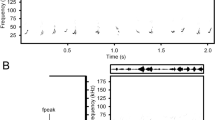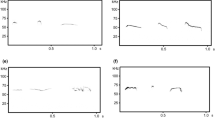Abstract
Females of several species of rodents are known to emit audible and ultrasonic sounds during same-sex encounters. There is very little information about factors affecting this vocalization. The present study was undertaken to investigate the effect of the stage of the reproductive cycle on vocalization and behaviour of adult bank vole females during various same-sex encounters. Pregnancy and lactation were studied as important phases of female life. The possible role of ovarian hormones in the emission of acoustic signals was also investigated as these hormones are known to be important in the regulation of other female social behaviour. The behaviour and vocalization of sexually naive, ovariectomized, pregnant and lactating females were studied using 10-min confrontation tests. The results demonstrate that the behaviour displayed and the emission of sounds in female–female bank vole encounters depend on the phase of reproductive cycle. Ultrasounds are produced more often by sexually naive and ovariectomized females which present mainly non-aggressive behaviour than by more aggressive lactating females. Audible sounds are emitted only occasionally by naive and by ovariectomized females but pregnant and especially lactating females emitted such calls more often, with shorter latencies and for longer than the unmated groups. Ultrasonic vocalization therefore seems to be related to non-aggressive behaviour and audible vocalization to aggression.


Similar content being viewed by others
References
Albert DJ, Petrovic DM, Walsh ML (1989) Ovariectomy attenuates aggression by female rats cohabiting with sexually active sterile males. Physiol Behav 45:225–228
Albert DJ, Jonik H, Walsh ML (1992) Interaction of estradiol, testosterone and progesterone in the modulation of hormone-dependent aggression in the female rat. Physiol Behav 52:773–779
Boyce CCK, Boyce JK (1988) Population biology of Microtus agrestis. I. Lifetime reproductive success of solitary and grouped breeding females. J Anim Ecol 57:711–722
Brudzyński SM, Fletcher NH (2010) Rat ultrasonic vocalization: short-range communication. In: Brudzyński SM (ed) Handbook of mammalian vocalization: an integrative neuroscience approach. Academic, London, pp 69–76
Bujalska G (1970) Reproduction stabilizing elements in an island population of Clethrionomys glareolus (Schreber, 1780). Acta Theriol 20:41–56
Bujalska G (1990) Social system of the bank vole, Clethrionomys glareolus. In: Tamarin RH, Ostfeld RS, Pugh SR, Bujalska G (eds) Social systems and population cycles in voles. Birkhäuser Verlag, Basel, pp 155–167
Bujalska G, Saitoh T (2000) Territoriality and its consequences. Pol J Ecol 48:37–49
Cherry JA, Lepri JJ (1986) Sexual dimorphism and gonadal control of ultrasonic vocalizations in adult pine voles, Microtus pinetorum. Horm Behav 20:34–48
Costantini F, D’Amato FR (2006) Ultrasonic vocalizations in mice and rats: social context and functions. Acta Zoolog Sin 52:619–633
Floody OR (1979) Behavioral and physiological analyses of ultrasound production by female hamsters (Mesocricetus auratus). Am Zool 19:443–456
Floody OR, Pfaff DW, Lewis CD (1977) Communication among hamsters by high-frequency acoustic signals: determinants of calling by females and males. J Comp Physiol Psychol 91:807–819
Frank DH, Johnston RE (1981) Determinants of scent marking and ultrasonic calling by female Turkish hamsters, Mesocricetus brandti. Behav Neural Biol 33:514–518
Haney M, Miczek KA (1993) Ultrasounds during agonistic interactions between females rats (Rattus norvegicus). J Comp Psychol 107:373–379
Hoffmeyer I, Sales GD (1977) Ultrasonic behaviour of Apodemus sylvaticus and A. flavicollis. Oikos 29:67–77
Humphreys EM, Ghione R, Gosden RG, Hobson BM (1985) Relationship between corpora lutea or fetal number and plasma concentrations of progesterone and testosterone in mice. J Reprod Fertil 75:7–15
Kapusta J (1998) Gonadal hormones and intrasexual aggressive behaviour in female bank voles (Clethrionomys glareolus). Aggress Behav 24:63–70
Kapusta J, Marchlewska-Koj A (1998) Interfemale aggression in adult bank voles (Clethrionomys glareolus). Aggress Behav 24:53–61
Kapusta J, Pachinger K, Marchlewska-Koj A (1999) Behavioural variation in two populations of root voles. Acta Theriol 44:337–343
Kapusta J, Szentgyörgyi H, Surov A, Ryurikov G (2006) Vocalization of two palaearctic species of hamster: Eversmann hamster Allocricetulus eversmanni and grey hamster Cricetulus migratorius. Bioacoustics 15:315–330
Kapusta J, Sales GD, Czuchnowski R (2007) Aggression and vocalization behaviour of three sympatric vole species during conspecific and heterospecific same-sex encounters. Behaviour 144:283–305
Koskela E, Mappes T, Ylönen H (1997) Territorial behaviour and reproductive success of bank voles Clethrionomys glareolus. Acta Theriol 39:365–371
Lepri J, Theodorides M, Wysocki CJ (1988) Ultrasonic vocalizations by adult prairie voles Microtus ochrogaster. Experientia 44:271–273
Maggio J, Whitney G (1985) Ultrasonic vocalizing by adult female mice, Mus musculus. J Comp Psychol 99:420–436
Mann MA, Konen C, Svare B (1984) The role of progesterone in pregnancy-induced aggression in mice. Hormon Behav 18:140–160
Marchlewska-Koj A, Kołodziej B, Filimowska A (1989) Aggressive behaviour of adult bank voles (Clethrionomys glareolus) towards conspecifics. Aggres Behav 15:381–387
Marchlewska-Koj A, Kapusta J, Sales DG, Kruczek M (1994) Ultrasonic calls of bank voles in response to conspecific chemosignals. In: Apfelbach R, Müller-Schwarze D, Reutter K, Weiler E (eds) Advances in the biosciences. Pergamon, Oxford, pp 371–376
Matochik JA, White NR, Barfield RJ (1992) Variations in scent marking and ultrasonic vocalizations by Long–Evans rats across the estrous cycle. Physiol Behav 51:783–786
Mayer AD, Reisbick S, Siegel HI, Rosenblatt JS (1987) Maternal aggression in rats: changes over pregnancy and lactation in a Sprague–Dawley strain. Aggress Behav 13:29–43
Mazurkiewicz M (1971) Shape, size and distribution of home ranges of Clethrionomys glareolus (Schreber, 1780). Acta Theriol 16:23–60
McGinnis MY, Vakulenko M (2003) Characterization of 50-kHz ultrasonic vocalizations in male and female rats. Physiol Behav 80:81–88
Moles A, D’Amato FR (2000) Ultrasonic vocalization by female mice in the presence of a conspecific carrying food cues. Anim Behav 60:689–694
Moles A, Costantini F, Garbugino L, Zanettini C, D’Amato RD (2007) Ultrasonic vocalizations emitted during dyadic interactions in female mice: a possible index of sociability? Behav Brain Res 182:223–230
Nubbemeyer R (1999) Progesterone and testosterone concentrations during oestrus cycle and pregnancy in the common vole (Microtus arvalis Pallas). Comp Biochem Physiol A 122:437–444
Nyby J (1983) Ultrasonic vocalizations during sex behavior of male house mice (Mus musculus): a description. Behav Neural Biol 39:128–134
Parmigiani S, Brain PF, Mainardi D (1988) Different patterns of biting attack generated when lactating female mice encounter male and female conspecific intruders. J Comp Psychol 102:287–293
Rosenblatt JS, Factor EM, Mayer AD (1994) Relationship between maternal aggression and maternal care in the rat. Aggress Behav 20:243–255
Sales GD (1972a) Ultrasound and aggressive behaviour in rats and other small mammals. Anim Behav 20:88–100
Sales GD (1972b) Ultrasounds and mating behaviour in rodents with some observations on other behavioural situations. J Zool Lond 168:149–164
Sales GD (2010) Ultrasonic calls of wild and wild-type rodents. In: Brudzyński SM (ed) Handbook of mammalian vocalization: an integrative neuroscience approach. Academic, London, pp 77–88
Sales GD, Smith JC (1978) Comparative studies of the ultrasonic calls of infant murid rodents. Dev Psychobiol 11:595–619
Sandnabba NK (1993) Female aggression during gestation and lactation in two strains of mice selected for isolation-induced intermale aggression. Behav Process 30:157–164
Sewell GD (1970) Ultrasonic communication in rodents. Nature (London) 227:410
Smith JC (1979) Factors affecting the transmission of rodent ultrasounds in natural environments. Am Zool 19:432–442
Smith JC, Sales GD (1980) Ultrasonic behavior and mother–infant interactions in rodents. In: Smotherman R, Bell R (eds) Maternal influences and early behavior. Spectrum Publications Inc., New York, pp 103–133
Stoddart DM, Sales GD (1985) The olfactory and acoustic biology of wood mice, yellow necked mice and bank voles. In: Flowerdew JR, Gurnell J, Gipps JHW (eds) The ecology of woodland rodents bank voles and wood mice. Proc. Symp. Zool. Soc. Lond. Clarendon Press, Oxford, pp. 117–139
Thomas DA, Barfield RJ (1985) Ultrasonic vocalization of the female rat (Rattus norvegicus). Anim Behav 33:720–725
Thomas DA, Takahashi LK, Barfield RJ (1983) Analysis of ultrasonic vocalizations emitted by intruders during aggressive encounters among rats (Rattus norvegicus). J Comp Psychol 97:201–206
White NR, Colona LC, Barfield RJ (1991) Sensory cues that elicit ultrasonic vocalizations in female rats (Rattus norvegicus). Behav Neural Biol 55:154–165
Whitney G, Coble JR, Stockton MD, Tilson EF (1973) Ultrasonic emissions: do they facilitate courtship of mice? J Comp Physiol Psych 84:445–452
Wolff JO (1985) Maternal aggression as a deterrent to infanticide in Peromyscus leucopus and P. maniculatus. Anim Behav 33:117–123
Acknowledgements
The author is deeply grateful to Dr. Gillian Sales for advice and helpful comments on the manuscript. This work was supported by grants from the Polish State Committee for Scientific Research (DS/V/WBiNoZ/UJ/757/08).
Author information
Authors and Affiliations
Corresponding author
Additional information
Communicated by: Magdalena Niedziałkowska
Rights and permissions
About this article
Cite this article
Kapusta, J. Effect of the stage of the reproductive cycle on vocalization and behaviour in female bank voles. Acta Theriol 57, 145–152 (2012). https://doi.org/10.1007/s13364-011-0056-7
Received:
Accepted:
Published:
Issue Date:
DOI: https://doi.org/10.1007/s13364-011-0056-7




